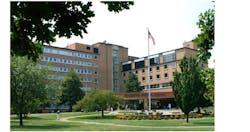At Rochester Regional Health, a Rapid Telehealth Response to COVID-19-Related Patient Care Needs
As the COVID-19 pandemic surges across the United States, patient care organization leaders are moving quickly to put into place processes and technologies that can help them optimally serve both patients with COVID-19 and potentially with COVID-19, and all their other patients, in the best ways possible.
At the five-hospital, 1,000-bed Rochester Regional Health integrated system in n Rochester, New York, Bridgette Wiefling, M.D., the health system’s senior vice president at its Primary Care and Ambulatory Specialty Institute, has been helping to lead an initiative to do precisely that.
Dr. Wiefling, who has spent nearly two decades in practice as an internal medicine specialist and pediatrician, gathered together with her colleagues early in February to leverage the telehealth network they already had in place and prepare to address an anticipated surge in patient care needs because of COVID-19. They moved forward quickly to partner with the Ramat Gan, Israel-based Datos Health, a healthcare information technology firm whose fully automated remote-care platform was already in use at the 1,700-bed Sheba Medical Center in Tel Aviv, where Eyal Zimlichman, M.D., a practicing internal medicine specialist and the hospital’s CMO and chief innovation officer, has been leading that organization’s telehealth initiative. Rochester Regional Health has partnered with Datos Health as its U.S. beta site, and the organization went live with its automated remote-care platform on March 20.
Dr. Wiefling spoke this week with Healthcare Innovation Editor-in-Chief Mark Hagland about their important initiative. Below are excerpts from their interview.
Tell me about the origins of this initiative?
What’s really important about this is that we believe that this is a really important tool for health systems across the U.S. to know about and contemplate using. We’re proud of our team for standing this up in ten days. We think it’s a very important tool that others need to take advantage of. I think it’s the responsible thing to do as a provider. It allows us to be efficient.
How does it work?
In New York state, we did not have access to testing at the levels we needed them, for COVID-19. And our specific county, Monroe County, could only do 20 tests per day through the county. It was just very, very limited. So we were seeing all these patients who we knew were probably COVID-positive, but couldn’t be tested based on the very strict criteria from the county. And then we developed our own COVID test. And the county was directing us to ask people to self-isolate. If we were clinically identifying COVID, we needed to direct patients to go home and isolate for 14 days. And Cuomo had not yet implemented the shutdown, so our community was still in full activity. So we needed to get patients identified quickly and isolated at home.
At the same time, as physicians, we were telling patients, we believe you have COVID, and we’re asking you to isolate from your families and friends; and being medically isolated is very anxiety-producing, especially since there is a potential for death, even though 80 percent of patients do OK with the virus. So we needed to be able to touch base with patients regularly both from an emotional support standpoint and also to make sure to identify if they were getting sicker. We needed to know of course if it was time to send them to urgent care for x-rays and bloodwork, or to an ED, or at a minimum, to their primary care providers for checkups. And this was all happening in the midst of the onslaught of things. That was roughly March 10-13. We had already worked with Datos before, around some diabetes management opportunities; and one of our executives said to me, you need to see this [the Datos platform for remote monitoring]. So within ten minutes, I was on the phone with one of our IT leaders, working with him to get this through all of our channels and implement it. And that was actually before the President had relaxed all the HIPAA and privacy controls with the emergency order. So we actually started plowing through this under the old standards, and then the order came through. But I give a lot of kudos to our IT team and the Datos team, because they were running through the hurdles as they stood at that time.
So we started putting this together. And then we launched it, initially as a pilot with a couple of practices, beginning on March 11, and then expanding it more broadly across our system on March 20, when we put our first patient into the system. And we’re redeploying some of our workforce. As many of our providers as we can move into clinical care, we’re doing so. So our pathology team agreed to step up and help manage this patient population with us. So the way the tool works is that patients clinically identified as positive, we’ve built a smart form in Epic [the electronic health record from the Verona, Wisconsin-based Epic Systems Corporation] that the provider is documenting in, and that generates a report in the background that we can pull, to know which patients are being self-isolated, and then we can begin enrolling them. Once enrolled, the tool sends them a text message twice a day, asking questions, with a risk stratification algorithm running in the background. So a nurse or physician looking at the dashboard and can the colors—green, yellow, red; if they reach red, we can do a video visit or telephone call with them. And we’re able to touch base and do an assessment and find out whether they need to go to a higher level of care or not. We’re also able to do some patient education at the same time. And the feedback from patients has been fantastic, both from their not feeling alone, to their getting to the right level of care.
How many patients have been monitored so far?
I don’t know the precise number. We put in three of our large practices first. And we’ve got nearly 500 patients in self-isolation, so some percentage of that number. And we’re upscaling it. We’ve just trained our pathology team who will take this on for us, and they’ll go live on Friday to expand this, and a few other nurses have also joined the team.
Have there been any challenges in all this?
There definitely have been challenges, yes. So, a couple of challenges in particular: first has been getting the workflow right, making sure we’re keeping the primary care providers in the loop and are a part of offering it. And getting the PCPs trained on the smart-form, and using it. Trying to figure out how to make decisions about double management of patients who are employees and patients. Our first use case was patients suspected of being positive, then we added COVID-positive patients in; then we stood up an arm for exposed healthcare workers. And it’s fabulous for that, too. If you’re a non-healthcare worker, it’s a 14-day isolation. If you’re a healthcare worker, it’s a minimum of seven days if you’re symptomatic, to be in isolation, and three more days of being symptom-free, before you can go back to work. Remember, 80 percent of patients with COVID-19 have mild symptoms. Thank goodness we haven’t had too many positives among our workers; but we’re expecting that to surge.
Are you anticipating additional challenges because of the nationwide PPE shortage, and that more clinicians might become positive?
I don’t think so, because I believe health systems are figuring out how to keep their workers safe; I know we are. And one of the things we did. I’m very proud of our organization; I think they’ve managed this exquisitely given the rapidity of the onslaught. We went to a local manufacturer. And we designed a special face shield, and they’re able to make over 1,000 a day; so every employee is getting a face shield. We’ve really banded together as a health system and have embraced our community, and have not been relying on that we can’t control. It looks a bit like Darth Vader, but they’re clear. Dr. Ralph Pennino, on the acute-care side, has done a great job, and that was one of his pet projects.
What have been the biggest lessons learned so far, in all this?
As healthcare providers, the thing that holds us all together is that we’re healers. And when you listen to the patients and you keep that patient and that healing mentality at the forefront, you make really good decisions, and I think that this was one of those really good decisions. Very patient-focused. And if you’re going to stand up a project like this quickly, get everyone involved right away, IT, clinical, legal; don’t try to do this in a silo. We decided it was OK to double-manage our patients who are employees, even though they’re being watched by employee health. And getting four text messages a day isn’t a bad thing; we just have to stagger the times involved.
We also partnered with our county; counties are woefully underfunded everywhere. So we have a really great relationship with our counties. We reached out to our main county, Monroe County; we thought they might be able to use this well with COVID-positive patients. So we introduced them to the tool.
Do you have any final thoughts, for your colleagues across the U.S. healthcare system, as they consider how to address the coming surge in COVID-19 cases?
I think this is teaching us how to be nimble as a healthcare system. Healthcare in general has not typically been very nimble; this has helped us to become more nimble to adapt to a very tragic epidemics. It’s very important that we take these lessons learned and apply them going forward. And in that, we were very lucky. At Rochester Regional Health, we’ve been an innovative leader for a while, and we had a strong telehealth arm that was already operating. We’ve been doing telehealth for over 15 years, helping specialty to specialty, overseeing rural ICUs at a distance, and so on. We had recently stood up an employee after-hours virtual visit tele line for our employees, called CareNow; we were able to leverage that. We wanted to keep as many people out of the office as we could, to not have workers exposing patients and vice-versa. So being ready with these kinds of technologies is very important.
I think the telehealth world will blossom and stay, after this. We’re going to have to learn as providers how to continue to use technology appropriately; not everything can be done by telehealth. But we had had a group of physicians we had pulled together early on, before telehealth, to discuss how you safely use telehealth, and set parameters around it. We think it’s dangerous to have large groups of online providers working only online with patients; we don’t think that’s a good idea. So we’ve been carefully rolling out telehealth over time anyway. COVID-19 forced us to accelerate our further rollout.
And we’ve been advocates for parity. And some of the parity arguments started in Rochester, New York, with Excellus BCBS, and we’ve been able to work out the parity issues around payment for telehealth here. And it becomes more and more important that we have telehealth options where we can. And technology can actually help your patients to feel safe and cared for during this time.


